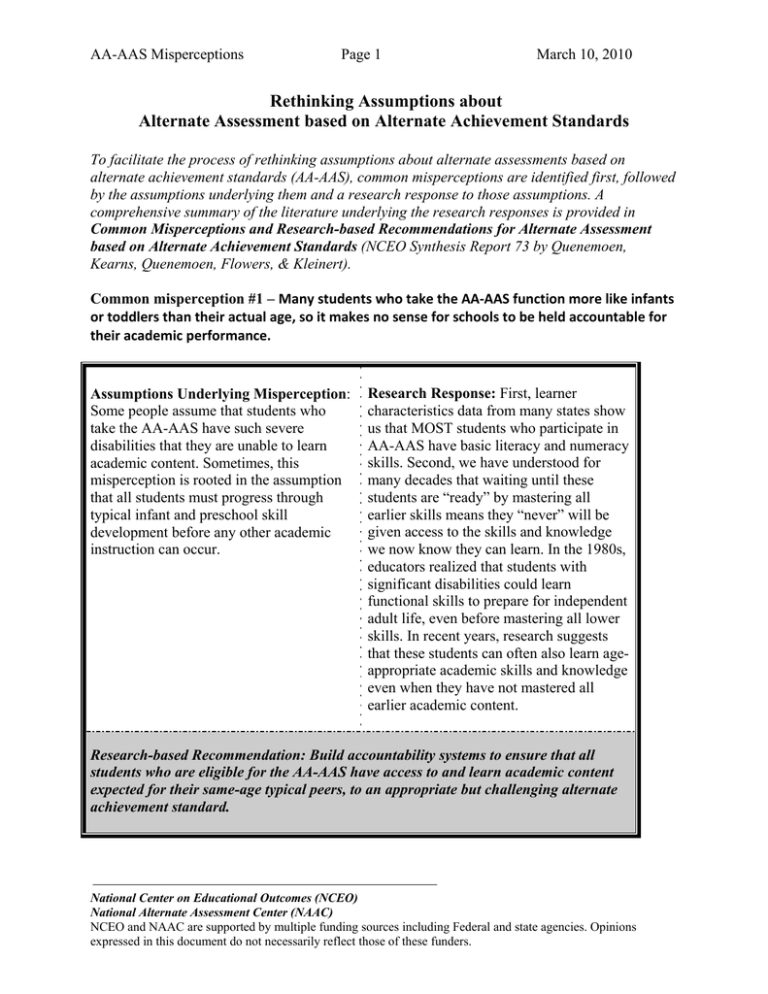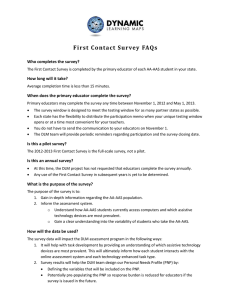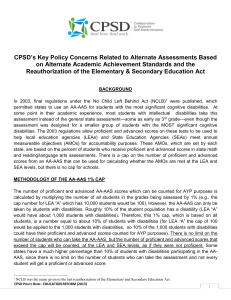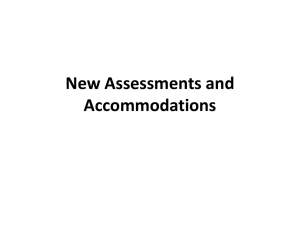Rethinking Assumptions about Alternate Assessment based on Alternate Achievement Standards
advertisement

AA-AAS Misperceptions Page 1 March 10, 2010 Rethinking Assumptions about Alternate Assessment based on Alternate Achievement Standards To facilitate the process of rethinking assumptions about alternate assessments based on alternate achievement standards (AA-AAS), common misperceptions are identified first, followed by the assumptions underlying them and a research response to those assumptions. A comprehensive summary of the literature underlying the research responses is provided in Common Misperceptions and Research-based Recommendations for Alternate Assessment based on Alternate Achievement Standards (NCEO Synthesis Report 73 by Quenemoen, Kearns, Quenemoen, Flowers, & Kleinert). Common misperception #1 – Many students who take the AA‐AAS function more like infants or toddlers than their actual age, so it makes no sense for schools to be held accountable for their academic performance. Assumptions Underlying Misperception: Some people assume that students who take the AA-AAS have such severe disabilities that they are unable to learn academic content. Sometimes, this misperception is rooted in the assumption that all students must progress through typical infant and preschool skill development before any other academic instruction can occur. Research Response: First, learner characteristics data from many states show us that MOST students who participate in AA-AAS have basic literacy and numeracy skills. Second, we have understood for many decades that waiting until these students are “ready” by mastering all earlier skills means they “never” will be given access to the skills and knowledge we now know they can learn. In the 1980s, educators realized that students with significant disabilities could learn functional skills to prepare for independent adult life, even before mastering all lower skills. In recent years, research suggests that these students can often also learn ageappropriate academic skills and knowledge even when they have not mastered all earlier academic content. Research-based Recommendation: Build accountability systems to ensure that all students who are eligible for the AA-AAS have access to and learn academic content expected for their same-age typical peers, to an appropriate but challenging alternate achievement standard. National Center on Educational Outcomes (NCEO) National Alternate Assessment Center (NAAC) NCEO and NAAC are supported by multiple funding sources including Federal and state agencies. Opinions expressed in this document do not necessarily reflect those of these funders. AA-AAS Misperceptions Page 2 March 10, 2010 Common Misperception #2 – Many students who participate in AA-AAS have lifethreatening medical conditions or are not able to communicate. Assumptions Underlying Misperception: People sometimes assume that AA-AAS students are a small homogeneous group of students with multiple problems that go well beyond what schools can actually handle; these students cannot speak, hear, or communicate in any way. Research Response: Students who participate in AA-AAS are generally less than 1% of the total student population or about 9% of all students with disabilities. Most of the students who take the AAAAS (90%) have consistent communication skills. Only about 10% of AA-AAS students communicate on a presymbolic level (without intentional use of language, pictures, objects, or signs). These students can communicate, but need to be given opportunities to learn effective strategies, including the use of assistive devices. Research-based Recommendation: For the small group of students who initially demonstrate a lack of symbolic communication (about 10% of students who take the AA-AAS), educators should persistently and systematically seek multiple and varied communication strategies including assistive technology to permit these students to learn and then to show what they know on an AA-AAS. National Center on Educational Outcomes (NCEO) National Alternate Assessment Center (NAAC) NCEO and NAAC are supported by multiple funding sources including Federal and state agencies. Opinions expressed in this document do not necessarily reflect those of these funders. AA-AAS Misperceptions Page 3 March 10, 2010 Common misperception #3: Students in the AA-AAS can learn only rote academic skills, so AA-AAS should reflect only these skills. Assumptions Underlying Misperception: People sometimes assume that the curriculum for students with severe disabilities often has been based on math skills of time and money and reading skills limited to sight words because that is all these students can learn. Research Response: It is true that research through the 1990s reflects a very narrow curriculum. Researchers now are finding strong evidence of academic skills and knowledge development among these students, including abstract concepts and transfer of learning, for students who participate in AA-AAS. We are only beginning to learn what these students are capable of, once given the opportunity to learn and access to appropriate accommodations such as assistive technology. In our work with states, we have encountered many teachers who have been “surprised and amazed” at what their students are able to learn when given the chance. Research-based Recommendation: Build AA-AAS approaches based on a model of academic content development that allows these students to demonstrate a range of grade-level content that their peers are also learning and demonstrating. National Center on Educational Outcomes (NCEO) National Alternate Assessment Center (NAAC) NCEO and NAAC are supported by multiple funding sources including Federal and state agencies. Opinions expressed in this document do not necessarily reflect those of these funders. AA-AAS Misperceptions Page 4 March 10, 2010 Common Misperception #4 – The AA-AAS has eliminated the teaching of important functional skills. Assumptions Underlying Misperception: People sometimes assume that the addition of academics to the curriculum for students with severe disabilities means that there is limited time for teaching functional skills like self-care, community participation, and safety. There is not enough time in the day to do both. Research Response: AA-AAS are designed to ensure students with significant cognitive disabilities are taught academic content like their peers, but a student’s IEP will often still include important functional skill goals. Many teachers have found that blended instruction in academic and functional skills yields better results for both. The “line” between academics and functional instruction begins to blur as teachers and parents discover how truly useful and satisfying increased literacy and numeracy skills are for these students, for quality of life and enjoyment, for integration into the community, school, or adult life, and for future employment. Research-based Recommendation: Provide training and support to teachers so that they can effectively merge academic and functional instruction where appropriate and so that they understand the vital importance of academic skills and knowledge to full participation in family, school, and community life. National Center on Educational Outcomes (NCEO) National Alternate Assessment Center (NAAC) NCEO and NAAC are supported by multiple funding sources including Federal and state agencies. Opinions expressed in this document do not necessarily reflect those of these funders. AA-AAS Misperceptions Page 5 March 10, 2010 Common misperception #5 – AA-AAS must cover all of the same content that is on the general assessment for typical peers. Assumptions Underlying Misperception: People sometimes assume that the gradelevel curriculum is very challenging and has far too much information for these students to cover in a year, let alone learn at all, but federal law requires the same content on all tests. Research Response: Federal regulations permit states to define the appropriate depth, breadth, and complexity of content coverage for the AA-AAS. Researchers are working on ways that students can access grade-level content at various “entry points.” States must show that these content priorities truly “raise the bar” of historically low expectations, and are clearly linked to the content that typical students in the same grade should know and be able to do. Since this is a shift for teachers who do not have experience with this content, training and support to teachers is an essential component of high quality alternate assessments. Research-based Recommendation: Provide training to teachers, and to other key assessment system stakeholders and advisors, on what research suggests these students are able to know and do when given the opportunity. National Center on Educational Outcomes (NCEO) National Alternate Assessment Center (NAAC) NCEO and NAAC are supported by multiple funding sources including Federal and state agencies. Opinions expressed in this document do not necessarily reflect those of these funders. AA-AAS Misperceptions Page 6 March 10, 2010 Common Misperception #6 – Most AA-AAS are entirely individualized and differ for each student. Assumptions Underlying Misperception: People sometimes assume that teachers make so much adaptation and adjustment to the assessment for each student that there is no way you can compare results from one school to another. Research Response: A good AA-AAS allows a defined amount of flexibility in administration of the items and tasks because students with the most significant cognitive disabilities vary in how they take in and respond to information and requests. Even so, AA-AAS must also adhere to basic standards of technical quality so that the scores can be compared for accountability purposes. An AA-AAS should incorporate training, oversight, and structures to balance flexibility with standardization of procedures and ongoing monitoring to ensure the assessments are administered, scored, and reported as intended. Research-based Recommendation: All AA-AAS scores should indicate whether the student is proficient in an academic domain through procedures that allow flexibility but control for possible sources of error. National Center on Educational Outcomes (NCEO) National Alternate Assessment Center (NAAC) NCEO and NAAC are supported by multiple funding sources including Federal and state agencies. Opinions expressed in this document do not necessarily reflect those of these funders. AA-AAS Misperceptions Page 7 March 10, 2010 Common Misperception #7 – An AA-AAS measures teacher performance in compiling attractive portfolios or examples rather than measuring student academic performance. Assumptions Underlying Misperception: People sometimes assume that teachers who are able to put together pretty portfolios or examples, or who can choose student examples that make them look good, will score higher than teachers who may teach well but who do not spend time creating pretty portfolios or examples of what their students do. Research Response: Given what we understand about student characteristics, most AA-AAS formats require test administrators familiar to the student. That means that in most cases, teachers interact with the student to capture accurate evidence of what the student knows and can do. A good AA-AAS is designed to control for administrative responses that are decorative, and to focus on independent student performance. Research has shown that teachers who are well-trained in instruction and assessment administration often have students with higher AA-AAS scores, but spending a lot of time making the portfolio “look good” has little impact on scores. Research-based Recommendation: Train teachers on systematic data gathering procedures, provide oversight, coaching, and monitoring to ensure they implement the procedures as intended, and design scoring processes to exclude evidence that reflects teacher behaviors instead of independent student performance. National Center on Educational Outcomes (NCEO) National Alternate Assessment Center (NAAC) NCEO and NAAC are supported by multiple funding sources including Federal and state agencies. Opinions expressed in this document do not necessarily reflect those of these funders. AA-AAS Misperceptions Page 8 March 10, 2010 Common Misperception #8 – It would make more sense if teachers simply reported on their students’ progress meeting IEP goals rather than requiring an AA-AAS. Assumptions Underlying Misperception: People sometimes assume that students with the most significant cognitive disabilities have IEPs that define what they should be learning. Gathering data that already are used for the IEP is the best measure of the students’ achievement. Research Response: A good IEP will identify the services, supports, and specialized instruction needed so that the student can learn both academic and functional skills and knowledge. Data gathered on the specific goals and objectives in the IEP are important for individual accountability among IEP team members for these short- and long-term goals and objectives, in all areas where the student has them. Some of these goals and objectives will specify the services and supports the student needs to access the general curriculum, but student progress based on the IEP does not provide accountability for student achievement of proficiency in the general curriculum. In contrast, AA-AAS are designed to provide data for system accountability to ensure that all students are provided access to and are achieving to proficiency in the general curriculum. Research-based Recommendation: Design AA-AAS so that there are comparable data on the effectiveness of schools in providing access to the general curriculum to students with the most significant cognitive disabilities. National Center on Educational Outcomes (NCEO) National Alternate Assessment Center (NAAC) NCEO and NAAC are supported by multiple funding sources including Federal and state agencies. Opinions expressed in this document do not necessarily reflect those of these funders. AA-AAS Misperceptions Page 9 March 10, 2010 Common Misperception #9 – Some AA-AAS formats (i.e., portfolio, checklist, performance assessment) are better than others. Assumptions Underlying Misperception: People sometimes assume that one method is better than another, with “better” meaning more technically adequate; the specific method that is considered better or worse often is based on good or bad experiences in the past. Research Response: Research on the technical quality of AA-AAS has shown that the format of the test is a poor predictor of technical quality. What a “portfolio” or “checklist” or “performance assessment” or what any other type of format name is can vary enormously, and a number of states now use hybrid models that combine elements of these approaches. Any of these types of formats can be of poor or high quality. A good AA-AAS should sensitively and accurately measure what students know and can do once they have been given appropriate access to interesting, age-appropriate academic content. Research-based Recommendation: Select the format of the AA-AAS based on beliefs about academic teaching and learning for AA-AAS students. National Center on Educational Outcomes (NCEO) National Alternate Assessment Center (NAAC) NCEO and NAAC are supported by multiple funding sources including Federal and state agencies. Opinions expressed in this document do not necessarily reflect those of these funders. AA-AAS Misperceptions Page 10 March 10, 2010 Common misperception #10 – No AA-AAS can be a technically adequate measure of student achievement for accountability purposes. Assumptions Underlying Misperception: People sometimes assume that the AAAAS breaks all the rules of good design of large-scale assessments as judged by high quality psychometric evidence that have been used by measurement experts for a century. Research Response: The challenges of designing AA-AAS are very new; prior to the 1990s, no large-scale assessment program included students with significant cognitive disabilities, and very few measurement experts had experience designing assessment for these students. Fortunately, there has been a great deal of work done since the 1990s on issues that have emerged in developing psychometrically sound AA-AAS. AA-AAS can be designed to produce valid and reliable information about student outcomes Research-based Recommendation: State assessment offices should address three components of the assessment design as they develop and implement the AA-AAS: (a) description of the student population and a theory of learning for these students, (b) structure of the observations from the assessment, and (c) interpretation of the results. The technical defense of an AA-AAS starts and ends with these three components. National Center on Educational Outcomes (NCEO) National Alternate Assessment Center (NAAC) NCEO and NAAC are supported by multiple funding sources including Federal and state agencies. Opinions expressed in this document do not necessarily reflect those of these funders.




